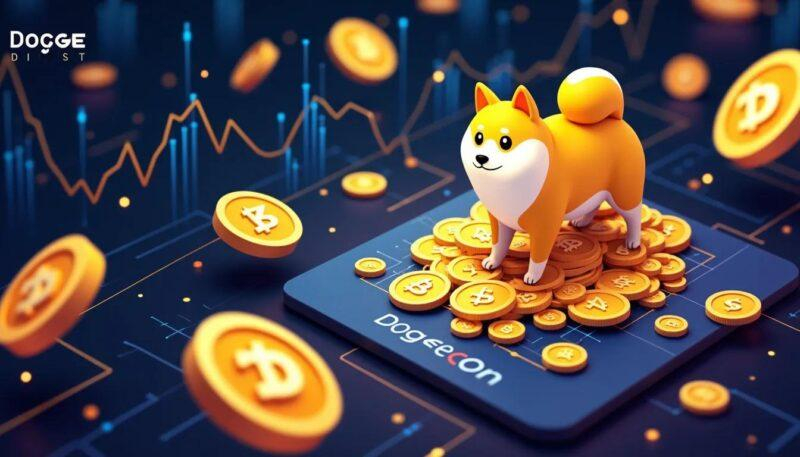Beneath the playful mascot and viral memes that propelled Dogecoin into the spotlight lies a sophisticated network humming quietly behind the scenes. While many recognize it as a quirky cryptocurrency with a loyal community, few pause to consider the intricate web of transactions that keep Dogecoin moving from one wallet to another. In this exploration, we’ll delve beyond the surface to uncover how Dogecoin transactions actually flow-revealing the mechanics, players, and processes that ensure every digital token finds its rightful place in the vast ledger. Whether you’re a crypto curious or a seasoned enthusiast, understanding these inner workings sheds new light on what powers this unconventional digital currency.
Understanding the Fundamentals of Dogecoin Transactions
At the heart of Dogecoin’s appeal lies a seamless transaction mechanism crafted to balance speed and simplicity. When a user initiates a transaction, they’re essentially signing off ownership of their Dogecoins to another participant’s digital address on the blockchain. This transaction then enters the mempool, where it waits to be validated by miners through a process known as proof of work. Successful miners bundle multiple transactions into a block, confirming their legitimacy and adding them permanently to the blockchain ledger.
Unlike some cryptocurrencies that prioritize scarcity, Dogecoin emphasizes high transaction throughput and low fees. This means transfers happen quickly and cost-effectively, making it popular for micropayments and tipping online. Transactions are broadcast widely through a decentralized network of nodes, ensuring transparency and security without relying on any central authority. Each transaction carries unique identifiers-inputs, outputs, and cryptographic signatures-that make tampering virtually impossible.
To better understand Dogecoin transactions, consider the fundamental components involved:
- Sender’s address: the wallet initiating the transfer.
- Recipient’s address: where the Dogecoins are sent.
- Transaction fee: incentives for miners to process the transfer.
- Block confirmation: the number of times the transaction is validated and added to the blockchain.
| Transaction Element | Role | Example |
|---|---|---|
| Input | References Dogecoins being spent | Previous transaction hash |
| Output | Specifies receiving address and amount | D7Y55G… |
| Signature | Proves ownership and authorization | Digital cryptographic signature |
Exploring the Role of Miners in Verifying Dogecoin Transfers
At the heart of Dogecoin’s vibrant network lies a dedicated group of participants known as miners. These miners play a crucial role in maintaining the blockchain’s integrity by validating every transfer. When a Dogecoin transaction is initiated, miners race to solve complex cryptographic puzzles, a process known as Proof of Work, which not only secures the network but also ensures that no double spending occurs. Their computational efforts confirm that transactions are legitimate and ready to be permanently recorded on the blockchain.
Mining is more than just puzzle-solving; it’s a system of checks and balances that keeps Dogecoin resilient against fraud and attacks. Miners bundle individual transactions into blocks, which are then verified and added sequentially to the chain. This block formation acts effectively as a digital ledger update. The first miner to crack the puzzle earns a block reward, incentivizing continuous participation. Interestingly, Dogecoin’s faster block time-typically just 1 minute-means confirmations happen quickly, allowing users to send and receive DOGE with impressive speed compared to some other cryptocurrencies.
- Transaction Verification: Ensures sender has sufficient DOGE balance.
- Block Creation: Groups transactions into a new block.
- Consensus Mechanism: Achieves network agreement via Proof of Work.
| Mining Aspect | Role | Impact |
|---|---|---|
| Proof of Work | Secures transactions through puzzle-solving | Network protection and transaction legitimacy |
| Block Rewards | Incentivizes miners | Encourages sustained mining activity |
| Fast Block Time | Speeds up transaction confirmation | Enhances user experience |
Decoding the Blockchain Ledger and Its Impact on Transaction Speed
At the heart of Dogecoin’s transaction process lies a blockchain ledger-a decentralized digital record that continuously updates with every validated transfer. Unlike traditional databases, this ledger operates across thousands of nodes worldwide, ensuring transparency and security through cryptographic consensus mechanisms. Each transaction is grouped into a block, which is then added sequentially to the chain after rigorous verification by miners. This structure, while robust, directly influences how quickly transactions are confirmed and finalized.
Speed in processing Dogecoin transactions hinges on multiple factors within this distributed ledger system:
- Block Time: Dogecoin’s average block creation time is approximately 1 minute, faster than Bitcoin’s 10 minutes, allowing quicker processing of new transactions.
- Network Congestion: When many transactions flood the network simultaneously, miners prioritize based on transaction fees, potentially slowing some confirmations.
- Consensus Protocol: The Proof-of-Work mechanism requires computational effort, influencing both security and the pace at which blocks are added.
| Factor | Impact on Speed | Typical Measure |
|---|---|---|
| Block Time | Determines interval between block additions | 1 minute |
| Network Congestion | Can delay transaction confirmation | Variable |
| Mining Difficulty | Affects time to solve cryptographic puzzles | Adjusts dynamically |
Security Measures and Common Vulnerabilities in Dogecoin Transfers
When sending Dogecoin from one wallet to another, security measures are paramount to ensure that transactions are safe and irreversible only once validated. One of the key defenses is the decentralized nature of the Dogecoin blockchain, which relies on miners to verify and record each transaction. This distributed verification process hinders malicious actors from forging transaction records or double-spending coins. Additionally, most wallets implement private key encryption, which protects users’ control over their Dogecoins, making unauthorized access extremely difficult without the private key itself.
However, despite these robust mechanisms, transfers can still fall prey to common vulnerabilities. A major risk arises from phishing attacks, where users might be tricked into revealing their private keys or seed phrases to impostors disguised as legitimate wallet services. Furthermore, man-in-the-middle (MITM) attacks can occur when users transact over insecure networks, potentially allowing attackers to intercept or manipulate transaction data. Another widespread issue involves wrong address inputs, which, due to the irreversible nature of blockchain transfers, can lead to permanent loss of funds if a typo is made.
| Common Vulnerabilities | Preventive Measures |
|---|---|
| Phishing Scams | Use official wallets and double-check URLs |
| Man-in-the-Middle Attacks | Prefer secure networks and VPNs |
| Incorrect Address Entry | Use QR codes or copy-paste addresses carefully |
| Private Key Exposure | Store keys offline or in hardware wallets |
Practical Tips for Ensuring Smooth and Secure Dogecoin Transactions
To keep your Dogecoin exchanges seamless, it’s essential to first verify the accuracy of the receiving address. Unlike traditional bank transfers, crypto addresses are long strings of characters that can easily be mistyped, leading to lost funds. Using a copy-paste approach combined with confirmation steps helps minimize errors. Another smart move is to enable 2-factor authentication (2FA) on your wallets and associated accounts-this simple layer of security shields you from unauthorized access and potential hacks.
Network fees can sometimes surprise users with delays or higher costs during peak times. Checking the current Dogecoin network status before initiating a transaction can save both time and money. Tools like mempool explorers or wallet notifications provide real-time insight into congestion, allowing you to adjust the transaction fee accordingly. Remember, paying a slightly higher fee can significantly speed up confirmation times, preventing unnecessary frustration.
Lastly, consider maintaining a transaction log, especially if you regularly send or receive Dogecoin. A simple table like the one below can help track amounts, dates, recipient addresses, and confirmation times, bringing clarity and ease to your crypto management:
| Date | Recipient Address | Amount (DOGE) | Status |
|---|---|---|---|
| 2024-05-12 | D7Y55Jg3Q54bKqM8HdZhpLmN5EP38ClkTX | 150 | Confirmed |
| 2024-05-15 | D9Qc2PfUiX3fLmBRPzShJq9XtGyNcEqTvo | 200 | Pending |
Q&A
Q&A: Unpacking Dogecoin – How Transactions Flow Behind the Scenes
Q1: What exactly is Dogecoin, and how does it differ from other cryptocurrencies?
A1: Dogecoin started as a playful take on the cryptocurrency craze, inspired by the Shiba Inu “Doge” meme. Unlike Bitcoin’s scarcity, Dogecoin boasts a high supply with an inflationary model, meaning new coins are continuously introduced. This, coupled with its vibrant community and low transaction fees, makes it more accessible for everyday tipping and microtransactions.
Q2: When you send Dogecoin, what actually happens behind the scenes?
A2: Think of sending Dogecoin as mailing a letter through a highly secure, decentralized postal service. Your transaction is bundled with others into a “block” by miners who race to solve complex puzzles-proof of work-to validate it. Once validated, your Dogecoin moves from your wallet to the recipient’s, recorded permanently on the blockchain, a public ledger that resists tampering.
Q3: How does the Dogecoin blockchain process transactions so quickly?
A3: Dogecoin’s block time is approximately 1 minute, much faster than Bitcoin’s 10 minutes. This means miners confirm blocks of transactions more frequently, leading to quicker transaction settlements. Additionally, Dogecoin’s relatively straightforward scripting language keeps things efficient, making small payments feel almost instantaneous.
Q4: What role do miners play in the Dogecoin network?
A4: Miners are the network’s gatekeepers and record keepers. They bundle, verify, and add transactions to the blockchain. By solving cryptographic puzzles-using computational power-they ensure that every Dogecoin transaction is legitimate and prevent fraud like double spending. In return, miners earn newly minted Dogecoins and transaction fees as rewards.
Q5: Can anyone become a Dogecoin miner?
A5: In principle, yes. Mining requires specialized hardware (ASICs or powerful GPUs) and a steady supply of electricity. Enthusiasts can join mining pools to combine resources and share rewards, making participation more feasible. However, the increasing competition means solo mining is less practical for most individuals today.
Q6: What happens if there are too many transactions at once? Does Dogecoin get clogged like other blockchains?
A6: Dogecoin’s design helps it handle smaller transaction volumes smoothly, thanks to its rapid block time and large supply reducing transaction competition. However, if demand spikes significantly, the network can experience delays and higher fees-though this is less common compared to congested networks like Ethereum. The Dogecoin community and developers often monitor and adjust to keep the flow steady.
Q7: How are Dogecoin transactions secured against fraud or hacking?
A7: Security relies on cryptographic algorithms and decentralized consensus. Each transaction requires a valid digital signature from the sender’s private key, proving ownership. The blockchain’s distributed nature means no single entity controls or can alter transaction history without the majority’s consensus, making fraud extremely difficult.
Q8: What tools can users employ to track Dogecoin transactions?
A8: Public block explorers are the go-to tools. Websites like Dogechain.info allow users to enter a wallet address or transaction ID to view transaction status, history, confirmations, and more. These transparent tools ensure users can verify their Dogecoin’s journey across the network anytime.
Q9: How does Dogecoin maintain decentralization as it grows?
A9: Decentralization stems from having many independent miners and nodes spread worldwide, each maintaining a copy of the blockchain. While mining consolidation can pose risks, Dogecoin’s open network and community-driven ethos encourage broad participation, helping keep power distributed.
Q10: What’s next for Dogecoin’s transaction technology?
A10: Dogecoin’s future may include integration with layer-two scaling solutions or interoperability with other blockchains to enhance speed and reduce costs. The community also explores improving wallet usability and privacy features, aiming to keep Dogecoin a fun, fast, and user-friendly cryptocurrency for all.
This Q&A peels back the curtain on Dogecoin’s transactional engine-a lively mix of cryptography, community, and code working tirelessly to send your digital coins across the globe.
Concluding Remarks
As we peel back the layers of Dogecoin’s bustling network, the intricate dance of transactions reveals a story of speed, community, and innovation quietly powering this playful cryptocurrency. While its origins may have started as a joke, the underlying mechanics show a serious, well-orchestrated system where every transfer adds a thread to the ever-growing tapestry of blockchain. Understanding how Dogecoin’s transactions flow behind the scenes not only demystifies the process but also invites us to appreciate the blend of technology and trust driving this unique digital currency forward. Whether you’re a seasoned crypto enthusiast or a curious newcomer, there’s no denying that behind Dogecoin’s friendly façade lies a fascinating world of decentralized movement-one block at a time.






